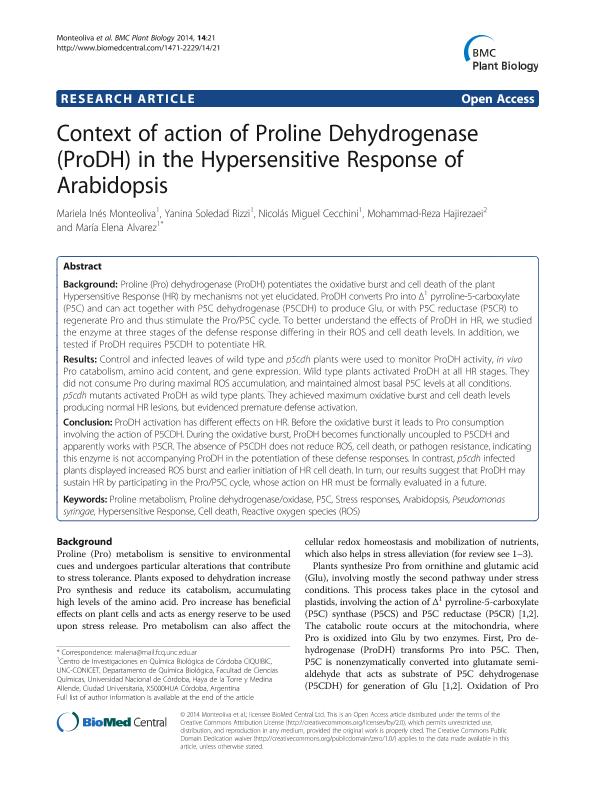Mostrar el registro sencillo del ítem
dc.contributor.author
Monteoliva, Mariela Inés

dc.contributor.author
Rizzi, Yanina

dc.contributor.author
Cecchini, Nicolas Miguel

dc.contributor.author
Hajirezaei, Mohammad Reza
dc.contributor.author
Alvarez, Maria Elena

dc.date.available
2018-01-03T14:29:52Z
dc.date.issued
2014-01
dc.identifier.citation
Alvarez, Maria Elena; Hajirezaei, Mohammad Reza; Cecchini, Nicolas Miguel; Rizzi, Yanina; Monteoliva, Mariela Inés; Context of action of Proline Dehydrogenase (ProDH) in the Hypersensitive Response of Arabidopsis; BioMed Central; BMC Plant Biology; 14; 1-2014; 21-32
dc.identifier.issn
1471-2229
dc.identifier.uri
http://hdl.handle.net/11336/32115
dc.description.abstract
Background:Proline (Pro) dehydrogenase (ProDH) potentiates the oxidative burst and cell death of the plantHypersensitive Response (HR) by mechanisms not yet elucidated. ProDH converts Pro intoΔ1pyrroline-5-carboxylate(P5C) and can act together with P5C dehydrogenase (P5CDH) to produce Glu, or with P5C reductase (P5CR) toregenerate Pro and thus stimulate the Pro/P5C cycle. To better understand the effects of ProDH in HR, we studiedtheenzymeatthreestagesofthedefenseresponsediffering in their ROS and cell death levels. In addition, wetested if ProDH requires P5CDH to potentiate HR.Results:Control and infected leaves of wild type andp5cdhplants were used to monitor ProDH activity,in vivoPro catabolism, amino acid content, and gene expression. Wild type plants activated ProDH at all HR stages. Theydid not consume Pro during maximal ROS accumulation, and maintained almost basal P5C levels at all conditions.p5cdhmutants activated ProDH as wild type plants. They achieved maximum oxidative burst and cell death levelsproducing normal HR lesions, but evidenced premature defense activation.Conclusion:ProDH activation has different effects on HR. Before the oxidative burst it leads to Pro consumptioninvolving the action of P5CDH. During the oxidative burst, ProDH becomes functionally uncoupled to P5CDH andapparently works with P5CR. The absence of P5CDH does not reduce ROS, cell death, or pathogen resistance, indicatingthis enzyme is not accompanying ProDH in the potentiation of these defense responses. In contrast,p5cdhinfectedplants displayed increased ROS burst and earlier initiation of HR cell death. In turn, our results suggest that ProDH maysustain HR by participating in the Pro/P5C cycle, whose action on HR must be formally evaluated in a future.
dc.format
application/pdf
dc.language.iso
eng
dc.publisher
BioMed Central

dc.rights
info:eu-repo/semantics/openAccess
dc.rights.uri
https://creativecommons.org/licenses/by-nc-sa/2.5/ar/
dc.subject
Proline Metabolism
dc.subject
Proline Dehydrogenase/Oxidase
dc.subject
P5c
dc.subject
Stress Responses
dc.subject
Arabidopsis
dc.subject
Pseudomonassyringae
dc.subject
Hypersensitive Response
dc.subject
Cell Death
dc.subject
Reactive Oxygen Species (Ros)
dc.subject.classification
Otras Ciencias Biológicas

dc.subject.classification
Ciencias Biológicas

dc.subject.classification
CIENCIAS NATURALES Y EXACTAS

dc.title
Context of action of Proline Dehydrogenase (ProDH) in the Hypersensitive Response of Arabidopsis
dc.type
info:eu-repo/semantics/article
dc.type
info:ar-repo/semantics/artículo
dc.type
info:eu-repo/semantics/publishedVersion
dc.date.updated
2017-12-29T14:14:25Z
dc.journal.volume
14
dc.journal.pagination
21-32
dc.journal.pais
Reino Unido

dc.journal.ciudad
Londres
dc.description.fil
Fil: Monteoliva, Mariela Inés. Consejo Nacional de Investigaciones Científicas y Técnicas. Centro Científico Tecnológico Conicet - Córdoba. Centro de Investigaciones en Química Biológica de Córdoba. Universidad Nacional de Córdoba. Facultad de Ciencias Químicas. Centro de Investigaciones en Química Biológica de Córdoba; Argentina
dc.description.fil
Fil: Rizzi, Yanina. Consejo Nacional de Investigaciones Científicas y Técnicas. Centro Científico Tecnológico Conicet - Córdoba. Centro de Investigaciones en Química Biológica de Córdoba. Universidad Nacional de Córdoba. Facultad de Ciencias Químicas. Centro de Investigaciones en Química Biológica de Córdoba; Argentina
dc.description.fil
Fil: Cecchini, Nicolas Miguel. Consejo Nacional de Investigaciones Científicas y Técnicas. Centro Científico Tecnológico Conicet - Córdoba. Centro de Investigaciones en Química Biológica de Córdoba. Universidad Nacional de Córdoba. Facultad de Ciencias Químicas. Centro de Investigaciones en Química Biológica de Córdoba; Argentina
dc.description.fil
Fil: Hajirezaei, Mohammad Reza. Leibniz Institute of Plant Genetics and Crop Plant Research. Gatersleben; Alemania
dc.description.fil
Fil: Alvarez, Maria Elena. Consejo Nacional de Investigaciones Científicas y Técnicas. Centro Científico Tecnológico Conicet - Córdoba. Centro de Investigaciones en Química Biológica de Córdoba. Universidad Nacional de Córdoba. Facultad de Ciencias Químicas. Centro de Investigaciones en Química Biológica de Córdoba; Argentina
dc.journal.title
BMC Plant Biology

dc.relation.alternativeid
info:eu-repo/semantics/altIdentifier/doi/http://dx.doi.org/10.1186/1471-2229-14-21
dc.relation.alternativeid
info:eu-repo/semantics/altIdentifier/url/https://bmcplantbiol.biomedcentral.com/articles/10.1186/1471-2229-14-21
Archivos asociados
